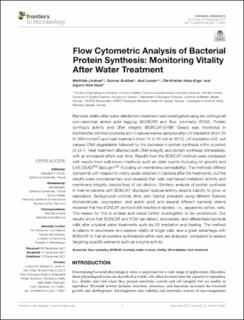| dc.contributor.author | Lindivat, Mathilde | |
| dc.contributor.author | Bratbak, Gunnar | |
| dc.contributor.author | Larsen, Aud | |
| dc.contributor.author | Hess-Erga, Ole-Kristian | |
| dc.contributor.author | Hoell, Ingunn Alne | |
| dc.date.accessioned | 2022-01-20T07:40:01Z | |
| dc.date.available | 2022-01-20T07:40:01Z | |
| dc.date.created | 2021-12-13T09:26:38Z | |
| dc.date.issued | 2021 | |
| dc.identifier.citation | Lindivat, M., Bratbak, G., Larsen, A., Hess-Erga, O.-K., & Hoell, I. A. (2021). Flow cytometric analysis of bacterial protein synthesis: Monitoring vitality after water treatment. Frontiers in Microbiology, 12. | en_US |
| dc.identifier.issn | 1664-302X | |
| dc.identifier.uri | https://hdl.handle.net/11250/2838378 | |
| dc.description.abstract | Bacterial vitality after water disinfection treatment was investigated using bio-orthogonal non-canonical amino acid tagging (BONCAT) and flow cytometry (FCM). Protein synthesis activity and DNA integrity (BONCAT–SYBR Green) was monitored in Escherichia coli monocultures and in natural marine samples after UV irradiation (from 25 to 200 mJ/cm2) and heat treatment (from 15 to 45 min at 55°C). UV irradiation of E. coli caused DNA degradation followed by the decrease in protein synthesis within a period of 24 h. Heat treatment affected both DNA integrity and protein synthesis immediately, with an increased effect over time. Results from the BONCAT method were compared with results from well-known methods such as plate counts (focusing on growth) and LIVE/DEAD™ BacLight™ (focusing on membrane permeability). The methods differed somewhat with respect to vitality levels detected in bacteria after the treatments, but the results were complementary and revealed that cells maintained metabolic activity and membrane integrity despite loss of cell division. Similarly, analysis of protein synthesis in marine bacteria with BONCAT displayed residual activity despite inability to grow or reproduce. Background controls (time zero blanks) prepared using different fixatives (formaldehyde, isopropanol, and acetic acid) and several different bacterial strains revealed that the BONCAT protocol still resulted in labeled, i.e., apparently active, cells. The reason for this is unclear and needs further investigation to be understood. Our results show that BONCAT and FCM can detect, enumerate, and differentiate bacterial cells after physical water treatments such as UV irradiation and heating. The method is reliable to enumerate and explore vitality of single cells, and a great advantage with BONCAT is that all proteins synthesized within cells are analyzed, compared to assays targeting specific elements such as enzyme activity. | en_US |
| dc.language.iso | eng | en_US |
| dc.publisher | Frontiers Media S.A. | en_US |
| dc.rights | Navngivelse 4.0 Internasjonal | * |
| dc.rights.uri | http://creativecommons.org/licenses/by/4.0/deed.no | * |
| dc.subject | flow cytometry | en_US |
| dc.subject | BONCAT | en_US |
| dc.subject | bacteria | en_US |
| dc.subject | water analysis | en_US |
| dc.subject | vitality | en_US |
| dc.subject | UV irradiation | en_US |
| dc.subject | heat treatment | en_US |
| dc.title | Flow Cytometric Analysis of Bacterial Protein Synthesis: Monitoring Vitality After Water Treatment | en_US |
| dc.type | Peer reviewed | en_US |
| dc.type | Journal article | en_US |
| dc.description.version | publishedVersion | en_US |
| dc.rights.holder | © 2021 Lindivat, Bratbak, Larsen, Hess-Erga and Hoell | en_US |
| dc.subject.nsi | VDP::Matematikk og Naturvitenskap: 400::Basale biofag: 470::Generell mikrobiologi: 472 | en_US |
| dc.source.pagenumber | 13 | en_US |
| dc.source.volume | 12 | en_US |
| dc.source.journal | Frontiers in Microbiology | en_US |
| dc.identifier.doi | 10.3389/fmicb.2021.772651 | |
| dc.identifier.cristin | 1967585 | |
| dc.relation.project | Trond Mohn stiftelse: TMS2018REK02 | en_US |
| cristin.ispublished | true | |
| cristin.fulltext | original | |
| cristin.qualitycode | 2 | |

